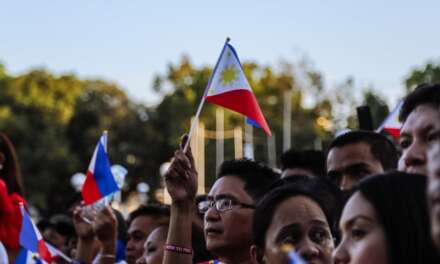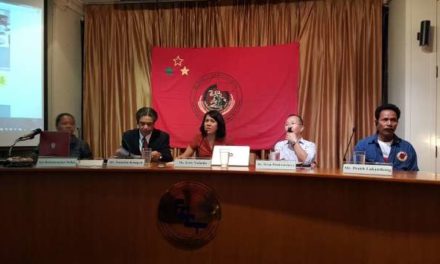It is now 622 days since Sombath Somphone, an eminent Lao thinker, development visionary and our dear friend, was abducted from a police post by men in police uniforms on a busy street in Vientiane, Lao PDR. His disappearance was captured on CCTV cameras installed to facilitate public security. Locating him and returning him safely to his family, and bringing his perpetrators to justice would not have been difficult. But to date, more than 18 months days since his abduction, Sombath remains missing, a victim of enforced disappearance. His abduction has not been investigated seriously and properly by the Lao Government. On the contrary, successive statements and actions by the Lao Government indicate a continuing denial of its basic responsibility and obligations. Today, August 30, marks the International Day of Victims of Enforced Disappearance. There is little doubt that the Lao Government can provide the answers that Sombath’s family, friends and indeed the world, seek. We urge it do so without any further delay. Posted below is a briefing prepared in March 2013. For further information, please see www.sombath.org Where is Sombath Somphone? Those who assert there is little civil society in the Lao PDR (Laos) have apparently never attended a celebration or festival in the country. Nor have they given due consideration to the staggering diversity of ethnicity and cultures, and the myriad and dynamic ways Lao communities have for centuries dealt with food shortages, natural disasters, and management and sharing of natural resources. Inside Laos, the current elite also seems to have forgotten that it was this same ability to organise and cope in the face of diverse, changing conditions that fed and sheltered the revolutionary struggle. But if one were to put a face to those aspects of Lao civil society more recognized at the national and international levels, it would be that of Sombath Somphone. Sombath grew up in rural Laos as the eldest child of a farming family. Passion, determination and a keen intellect led him through education at local, national and international institutions to obtain a BA in Education and an MA in Agriculture. While thousands of others were still fleeing Laos after the country gained independence in 1975, Sombath returned to work with the new government and his compatriots. Over the next three decades Sombath worked with remarkable persistence and humility to promote sustainable agriculture, participatory development and learner-centred education. In 2005, he received the prestigious Ramon Magsaysay Award for Community Leadership for “…his hopeful efforts to promote sustainable development in Laos by training and motivating its young people to become a generation of leaders.” Sombath is one of only two Lao citizens to receive this award, often called Asia’s Nobel Prize, in its 55-year history. A practicing Buddhist, Sombath advocates a holistic approach to living, guided by respect for nature, compassion and honesty. On the evening of December 15, 2012, Sombath Somphone was abducted at a major street in Vientiane after being stopped by the police. Recorded by a CCTV camera, the abduction shocked people inside the country and across the world. The abduction itself as well as the government’s responses, continue to raise many troubling questions and paint the Lao government in very poor light. Slow and shallow investigation Although Lao authorities have repeatedly stated that they take Sombath’s disappearance seriously and are investigating it thoroughly and intensively, the investigation has been slow, shallow and ridden with contradictions. Four days after Sombath’s disappearance and after CCTV footage of the event was obtained by family members and posted on the internet, a Lao government report released by the KPL News Agency acknowledged that Sombath’s Jeep had been stopped by traffic police, during which he got out of his Jeep to present documents to the police officers. This was confirmed by the Lao Permanent Representative to the United Nations on January 4th 2013. Yet on February 4th, 2013, another report released in the Vientiane Times contradicted the first one on several points and asserted the authorities could no longer identify whose Jeep it was, or who had driven it. Further, investigators now “…found that the driver walked out of the car and went to the area around the back of the Jeep” rather than to present documents to the police as had been reported earlier. The first report stated that soon after the jeep had been stopped, someone had arrived on a motorbike and rushed toward the police outpost. Yet the second report again omitted mention of the police or their outpost, saying only that the motorcycle driver “…. walked into the direction where the owner of the Jeep walked to.” The first account reported that someone had driven Sombath’s car away and several minutes later a “…pickup truck stopped near the police outpost.” But the second report stated that the pickup had stopped in the vicinity where the Jeep had parked. Notable in these contradictions are attempts to erase connections between the abduction and the police. Authorities claim that the police were conducting routine, random vehicle checks on December 15, but there is no evidence to support this in the more than 10 minutes of CCTV footage available. While police statements claim it is not possible to ascertain whether Sombath entered the pickup truck, the Permanent Secretary of the Ministry of Foreign Affairs told a delegation of visiting Parliamentarians that Sombath voluntarily boarded that vehicle, thus proving it was not forced abduction. The latest briefing by the Ministry of Public Security released on March 2, 2013 provides no new information and confirms the tardy pace of the investigation. At the same time, a great deal of misinformation slandering Sombath is being spread within the country through informal channels, as also are hints that it is not good for Lao people to ask or even talk about him. Posters about the disappearance of Sombath placed around Vientiane have been quickly removed. Why was Sombath taken? With virtually no meaningful results from the official investigation, speculation about why Sombath was taken has been both widespread and wide-ranging. Lao authorities have suggested it may have been due to a business or personal conflict, but have offered no supporting evidence. Rumours, many of them slanderous and ludicrous, have been rampant and range from his alleged opposition to the Xayabouri Dam to his collaborating with US-based opposition groups. Many believe that his disappearance resulted from his close involvement in the Asia-Europe People’s Forum (AEPF) held in mid-October, 2012. Sombath served as Co-Chair of the National Organising Committee for the event, was instrumental in organising popular input into the “Lao People’s Vision” statement prepared for the conference, and had also helped to follow-up cases of harassment of Lao citizens who had shared their views in some of the sessions. Sombath has always advocated sustainable development—much like senior Lao policy makers and the country’s “development partners.” And his relationship with the international world has been largely in the realm of teaching, and as speaker at conferences and lectures—again like other Lao scholars, government officials and NGO staff. The AEPF was organised in close collaboration with the Lao Ministry of Foreign Affairs and heralded as a crucial step forward for the country’s growing engagement in international processes. Even if the authorities were to conduct a serious investigation, the full details of the “who?” and “why?” behind Sombath’s abduction will likely not come to light. The United Nations High Commissioner for Human Rights has identified it as an enforced disappearance that could be related to his human rights work. What is increasingly evident though are the devastating effects of Sombath’s abduction on the evolution of Lao civil society, and on those Lao citizens who would advocate a more equitable and sustainable development path for their country. Sombath’s greatest influence has been with young people, who he inspires to learn, question, engage and act for collective good rather than individual gain. His abduction has spread extreme fear and insecurity among Lao people who aspire to exercise their citizenship and contribute constructively towards their country’s development. And this may well have been the intent behind the act. Losing credibility Sombath’s abduction has prompted a barrage of letters and statements of concern from parliamentarians, civil society organisations, scholars, Magsaysay award recipients and the human rights community, all calling for his release and safe return. The regional and international press have followed and reported the case with admirable regularity and responsibility. In Southeast Asia, Sombath’s abduction has been declared a slap in the face of ASEAN human rights initiatives and described as a deliberate act intended to suppress and threaten the emergence of independent and free thinking civil society actors in Laos. The lack of progress in the investigation has drawn comments from senior officials among Laos’ top donors including Switzerland, the European Union, Australia and the United States of America. Daniel Baer, deputy assistant secretary for the US State Department’s Bureau of Democracy, Human Rights and Labor said on February 19, “For as long as the case remains unresolved and Sombath doesn’t come home to his wife, the international community as well as many people here who know and love him will continue to ask questions.” From January 13-15, prominent parliamentarians from the Philippines, Malaysia and Indonesia met with their Lao counterparts and senior Lao government officials to exhort them to take urgent, appropriate action to secure Sombath’s release and safe return. One of the parliamentarians noted that, “…our visit raised more questions than answers.” Another said, “Now this raises fundamental questions…this actually shows that the police and civilian administration have absolutely no interest, no political will to get to the root of this problem…” The parliamentarians were told that Laos lacked the capability for sophisticated video analysis of the CCTV footage; but while the country relies on foreign assistance for many other things, from writing laws to maintaining public parks, assistance in this case has not been sought. On February 6, the European Parliament unanimously adopted a resolution on Sombath and expressed concern about “the tardiness and lack of transparency of the investigation into the disappearance of Sombath Somphone” and called on the Lao authorities “to undertake prompt, transparent and thorough investigations, in accordance with their obligations under international human rights law, and to ensure the immediate and safe return of Sombath Somphone to his family. ” The resolution acknowledged the intimidation provoked by Sombath’s disappearance and asked the Lao government to put an end to arbitrary arrests and secret detentions, make enforced disappearance a criminal offense and respect the rights of expression, association, of minorities and freedom of religion. On March 8, following meetings with Lao parliamentarians and senior government officials, Senator Tuur Elzinga from the Netherlands stated, “If Lao officials think the issue of Sombath’s disappearance will go away, they are wrong. It will be the first item on any agenda in bi-lateral, multi-lateral and international discussions with and about Laos, until Sombath is safely returned to his family.” Although space for political participation is extremely restricted in the country, Laos has somehow escaped the pariah label that dogged Myanmar until recently. But with Myanmar moving towards political pluralism, the world’s eyes will be on Laos, especially in light of Sombath’s abduction and continuing suppression of civil society voices. Laos seeks greater international recognition through its recently acquired membership in the World Trade Organization and the Asia-Europe Meeting (ASEM). It seeks to exit its status as a Least Developed Country but needs significant foreign assistance and investment to build the required infrastructure to do this. As Laos negotiates its way in these international spheres, a question that will haunt Lao officials in every space is, where is Sombath Somphone? For more information about Sombath, news and media reports and letters-statements, please see www.sombath.org
Where is Sombath Somphone?










